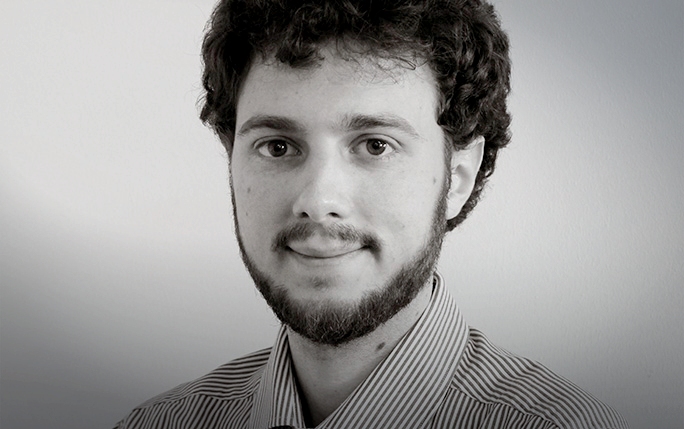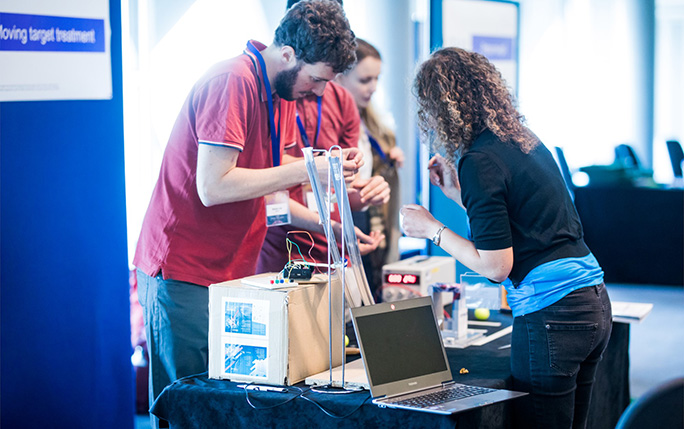Interview with Samuele Cotta

Samuele Cotta received his Bachelor’s degree in Physics in 2013 from the University of Insubria in Como (Italy). He undertook his Master’s studies at the University of Insubria, focusing on medical physics, and obtained his Master’s degree in Physics in March 2016 with a thesis about the characterization of an active detector for neutron flux measurements. In 2017 Samuele joined the OMA project at ViALUX in Chemnitz, Germany. He investigated the radiation hardness of the ViALUX 3D scanners which will be used in radiotherapy for patient positioning and monitoring. On 16th September 2019 Samuele got a position of physics technician at ARPA Lombardia, an Italian environmental protection agency.
What did attract you to the OMA network? Has it fulfilled your expectations?
"After my master’s degree I was looking for a challenging adventure, both for my work experience and for my personal life, so when I heard about the OMA network I had the feeling that it could be the right opportunity. During these years I had the chance to conduct a research project, working not only within ViALUX, but also collaborating with the other fellows and institutions within the OMA network. Beside this, I had a wonderful experience, living almost three years in a new country, learning a new language and discovering a different culture."
Why did you choose to go to ViALUX?
"I found the project at ViALUX really interesting because they offered me to explore a field which was almost new for both me and them: the radiation hardness of electronic devices. The perspective was to work together with colleagues with different backgrounds (e.g. informatics and electronic engineering), learning how to deal with a task from different perspectives and contributing with my point of view as a physicist. I also considered doing my project in a company as an additional value, because the approach to research is very different from the pure academic environment."
Can you explain in a few words what your project was about and what have you achieved?
"My project was focused on the optimization of optical 3D scanners to be integrated in the radiotherapy treatment rooms as devices for patient positioning and monitoring. I investigated in particular the radiation hardness of these devices, since they are exposed to the secondary radiation. Single electronic components as well as a whole 3D scanning device were tested during radiation tests both in irradiation facilities and in the real radiotherapy environment. The tests were successful and only few recoverable misbehaviours were detected when the devices were irradiated with irradiation conditions more severe than in the radiotherapy environment. In conclusion, the ViALUX 3D scanners turned out to be ready to be integrated and to work in the real radiotherapy facilities."
What has OMA provided you professionally?
"During my experience within OMA I had the chance to work in an international environment and to get in touch with many researchers from universities and big research centers. Attending the OMA schools and workshops I learnt a lot about the principle of particle therapy and its most recent developments and I improved my skills in scientific communication. Finally, I realized how important it is to not limit the research just to the host institution, but to establish links and collaborations outside too. Presenting and discussing the research results during schools and workshops was sometimes the best way to find new ideas for the project."
What will be your most cherished memory from OMA?
"I remember fondly my three-day trip to GSI to prepare with Harry and Michelle an experiment for the schools coming to the OMA Outreach Symposium. I always enjoy to share my passion for science with young students and it was great to spend a couple of days preparing an activity just for them. We put a lot of effort into this and it was amazing to see how what we planned via Skype became real. The whole OMA Outreach Symposium was a success thanks to the efforts of all the fellows from OMA, AVA and LIV.DAT networks and I hope that the young students who took part in it enjoyed it as much as us!"

Samuele Cotta setting up an outreach demonstration at the OMA Symposium.
And the one you’d rather forget?
"My "last“ evening with the other OMA fellows, which was last June in Liverpool, at the end of a one-week workshop focused also on our expectations for our future careers.
That event was a great opportunity for thinking about what we really wanted from our future, but at the same time it was a perfect point to turn back and realize how much I and the other fellows did and learnt in these years and how much we grew together within the OMA network."